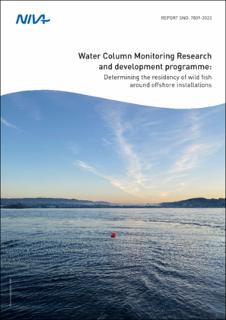| dc.contributor.author | Brooks, Steven | |
| dc.contributor.author | Beylich, Bjørnar | |
| dc.date.accessioned | 2023-02-16T12:22:45Z | |
| dc.date.available | 2023-02-16T12:22:45Z | |
| dc.date.created | 2023-02-15T14:05:20Z | |
| dc.date.issued | 2023 | |
| dc.identifier.isbn | 978-82-577-7545-2 | |
| dc.identifier.issn | 1894-7948 | |
| dc.identifier.uri | https://hdl.handle.net/11250/3051492 | |
| dc.description | Prosjektleder: Steven Brooks | en_US |
| dc.description.abstract | In order to link effects with exposure, recent WCM programmes have discovered the need to determine the residency of fish, caught from within the safety zone of offshore installations. The method of using baited tags to encourage the voluntary ingestion of acoustic tags was thought promising and work was commissioned to develop the baited tag concept for field application. Acoustic telemetry products such as receivers and tag transmitters were obtained from the Norwegian electronics manufacturer Thelma Biotel AS. Developmental work, consisting of a series of cod feeding experiments in large aquaria at the NIVA marine research station in Solbergstrand, discovered some important findings including food preferences, residency time of the tag in the stomach of the fish and excretion pathways. A field trial was conducted in the Trondheimsfjord and although only one tag was eaten the quality of the data was promising for offshore application. The good quality images from the underwater camera with light fixed to the fishing line was also considered suitable for species determination and able to visually document the interactions of the baited tags with the fish. The offshore trial of the baited tag system at Ekofisk proved to be unsuccessful due to the unsuitability of the two fish species present at Ekofisk. It was thought the baited tag system would be more suitable in deeper waters with more voracious fish such as ling, tusk and larger haddock or cod. The baited tag system will be carefully considered for future water column monitoring campaigns. | en_US |
| dc.description.sponsorship | Offshore Norway, represented by Equinor | en_US |
| dc.language.iso | eng | en_US |
| dc.publisher | Norsk institutt for vannforskning | en_US |
| dc.relation.ispartof | NIVA-rapport | |
| dc.relation.ispartofseries | NIVA-rapport;7809-2023 | |
| dc.subject | Produsert vann | en_US |
| dc.subject | Produced water | en_US |
| dc.subject | Bunnfisk og blåskjell | en_US |
| dc.subject | Demeral fish and mussels | en_US |
| dc.subject | Olje og gass | en_US |
| dc.subject | Oil and Gas | en_US |
| dc.subject | Biologiske effekter overvåkning | en_US |
| dc.subject | Biological effects monitoring | en_US |
| dc.title | Water Column Monitoring Research and development programme: Determining the residency of wild fish around offshore installations | en_US |
| dc.title.alternative | Water Column Monitoring Research and development programme: Determining the residency of wild fish around offshore installations | en_US |
| dc.type | Research report | en_US |
| dc.description.version | publishedVersion | en_US |
| dc.rights.holder | © Norsk institutt for vannforskning/Norwegian Institute for Water Research. The publication can be cited freely if the source is stated. | en_US |
| dc.subject.nsi | VDP::Matematikk og naturvitenskap: 400 | en_US |
| dc.subject.nsi | VDP::Mathematics and natural scienses: 400 | en_US |
| dc.source.issue | 7809-2023 | en_US |
| dc.identifier.cristin | 2126363 | |
| dc.relation.project | 200262.4 | en_US |
| dc.relation.project | 190104.3 | en_US |
| cristin.ispublished | true | |
| cristin.fulltext | original | |
